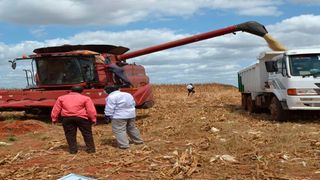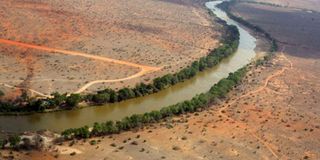
Galana- Kulalu irrigation project.
| File | Nation Media GroupNews
Premium
Name 10 powerful grabbers of Galana-Kulalu land, House team asks Lands ministry
A parliamentary committee now wants the Ministry of Lands to reveal the identities of 10 people that have grabbed 301,350 acres of land valued at Sh15 billion belonging to a State corporation.
The committee is set to meet officials from the ministry on Thursday next week as it seeks to unravel the story behind the grabbing of the land from the Agricultural Development Corporation (ADC) at Galana-Kulalu Food Security Project in Kilifi and Tana River counties.
“We need all copies related to this land and we will meet several government officials next week,” said the committee’s chairperson, Dr Rachael Nyamai.
“We will have an opportunity to look at the documents that will be presented by the National Land Commission,” she added.

Already building dams
In a meeting with the ADC management Tuesday, the committee heard that the 10 people are already building dams and other infrastructure on the land.
Appearing virtually before the committee, ADC Chairman Nick Salat said the parastatal did not have the identities of the 10 people and urged the investigative agencies to reveal them to the public.
“I am not in a position to give the names of the influential people. All we are interested in is getting back the land. It is up to investigative agencies to give out the names,” said Mr Salat.
“ADC is not just sitting back watching the land being grabbed. We are on the ground but people who have taken this land are not there,” Mr Salat added.
The committee is currently considering a public petition by Garsen residents regarding the subdivision of ADC land and stakeholder consultation on the Galana-Kulalu project.
“There is massive infrastructure development, mining and construction of dams going on the land, but all these are not in our records. We need to take back our land,” Mr Salat told MPs.

President Uhuru Kenyatta ploughs land using a tractor during the official ground breaking ceremony for the National Food Security Project at the Galana-Kulalu model farm in Tana River County in 2014.
Gazetted land
As government gazetted land, any sub-division, sale or transfer of the land must be taken to Parliament for ratification, he added. In this case, none of those procedures was followed.
“All our land was gazetted during Kibaki’s era, therefore, any sub-division needs the approval of Parliament,” Mr Salat said.
However, the committee’s vice chairperson, Mr Joshua Kutuny, accused ADC of failing to protect public land from the grabbers.
“If you come here and tell us that over 300,000 acres of land has been encroached [on] and this is public land, why do I see a team that is reluctant to protect our land? asked Mr Kutuny.
Mr Salat said the parastatal is working with the Kilifi County commissioner and the Lands ministry to ensure ADC gets back its land.

Tana River residents at the official launch of maize harvesting at the Galana-Kulalu Food Security Project on September 9, 2015.
Boost food security
In 2013, President Uhuru Kenyatta and his deputy William Ruto identified the Galana-Kulalu project in their manifesto on agriculture, aimed at boosting food security in the country.
The flagship project, however, failed to take off amid claims of corruption. A parliamentary committee touring the project recommended its termination on grounds that it was no longer viable.
In December 2015, the National Assembly Committee on Agriculture recommended that the Sh14 billion project be terminated, saying it had wasted taxpayers’ money. It also asked the Ethics and Anti-Corruption Commission to look into procurement irregularities.
In 2019, the government started turning part of the land on which the multi-billion-shilling food project is being implemented into an irrigation and settlement scheme.
The Ministry of Lands started surveying the land to pave way for private investors and host communities to be allocated the 1.75 million acres.





